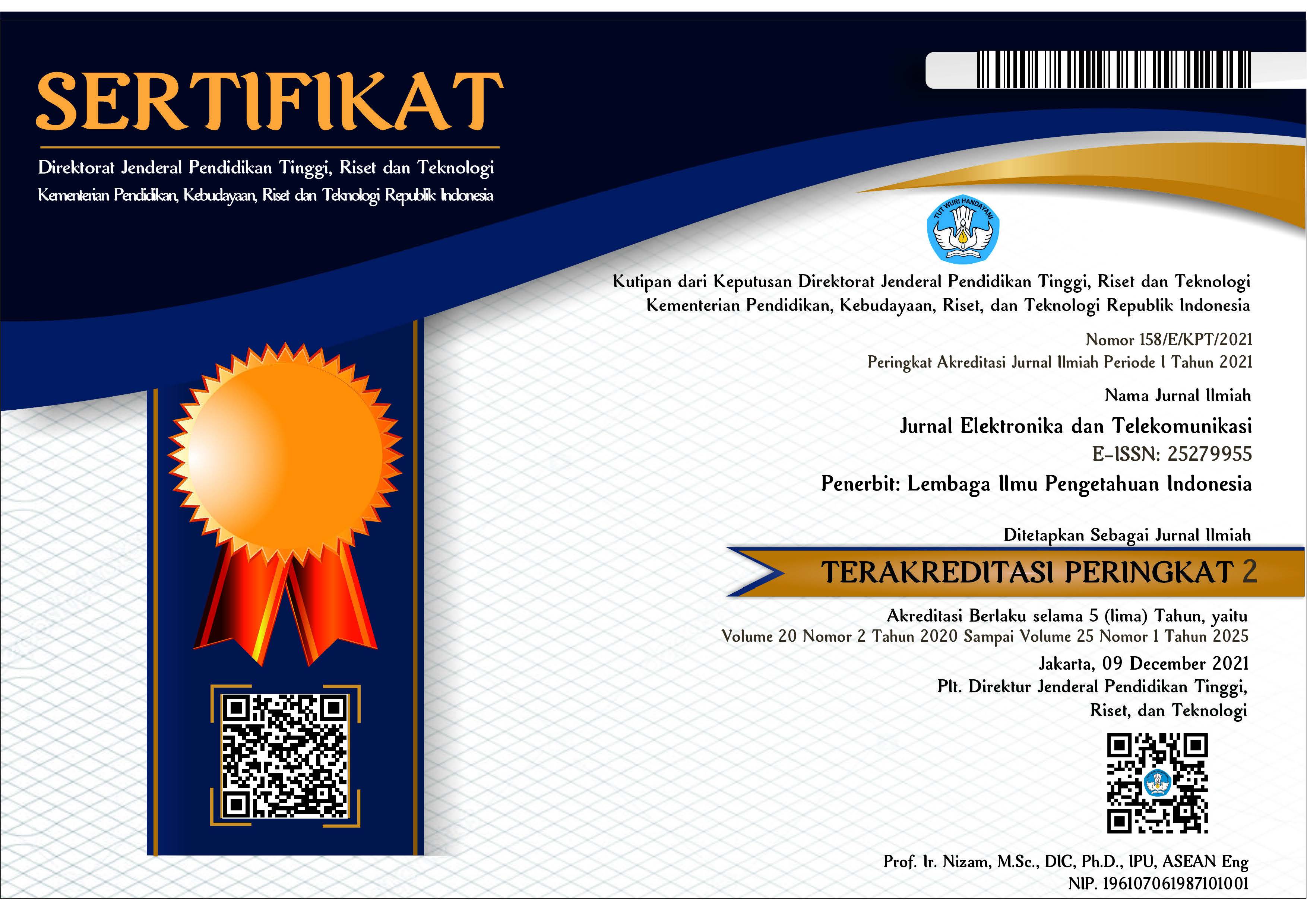Effect of Geometrical Structure to the Performance of Monolithic Dye–Sensitized Solar Cells
Abstract
Since invented for the first time, researchers in the world were focusing on how to increase the efficiency of dye-sensitized solar cells (DSSC) and reduce of the fabrication cost. Monolithic type of DSSC is one of the best solutions to reduce the fabrication cost due to the elimination of one of transparent conductive oxide (TCO) substrate. In this study, DSSC monolithic was fabricated layer by layer by using screen printing method. There are three layers that printed in each cell namely TiO2, ZrO2, and carbon before being injected with electrolytes. The geometrical structure of DSSC was varied to find the highest performance. From the I-V characteristics and incident photon-to-current efficiency (IPCE) characterization shows the highest efficiency is 0.137% and the highest conversion of photons to current occurs at around 510 nm wavelength, for a structure which has ZrO2 layer not crosses over the no-FTO area, while TiO2 layer half crosses the no-FTO area, this is most likely caused by the imperfection of the ZrO2layer.
Keywords
References
H. Hasnawiyah, “Perancangan Pembangkit Listrik Tenaga Surya Di Pulau Saugi”, Jurnal Riset dan Teknologi Kelautan, vol. 10, pp. 169-180, 2012.
(2017) The National Geographic website. [Online]. Available: https://environment.nationalgeographic.com
D. Susanti, M. Nafi, H. Purwaningsih, R. Fajarin and G.E Kusuma, “The Preparation of Dye Sensitized Solar Cell (DSSC) from TiO2 and Tamarillo Extract”, Procedia Chemistry, vol. 9, pp. 3-10, 2014. Crossref
B. O’Regan and M. Grätzel, “A Low-Cost, High-Efficiency Solar Cell Based on Dye-Sensitized Colloidal TiO2 Films”, Nature, no. 353, pp. 737-740, 1991. Crossref
K. Kalyanasundaram, Dye-Sensitized Solar Cells, 1st ed., Lausanne, Siwtzerland: EPFL Press, 2010.
S. Ito and K. Takahashi, “Fabrication of Monolithic Dye-Sensitized Solar Cell Using Ionic Liquid Electrolyte”, International Journal of Photoenergy, vol. 2012, pp. 1-6, 2012. Crossref
S. J. Thompson, N. W. Duffy, U. Bach, Y.-B Cheng, “On the Role of the Spacer Layer in Monolithic Dye-Sensitized Solar Cells”, Journal of Physic Chemistry C, vol. 114, pp. 2365–2369, 2010. Crossref
L. Vesce, R. Riccitelli, G. Mincuzzi, A. Orabona, G. Soscia, T.M. Brown, A. Di Carlo and A. Reale, “Fabrication of Spacer and Catalytic Layers in Monolithic Dye-Sensitized Solar Cells”, IEEE Journal of Photovoltaics, vol. 3, pp. 1004-1011, 2013. Crossref
H.T. Chou, K.M. Lin and H.C. Hsu, “Fabrication of TiO2 compact layer precursor at various reaction times for dye sensitized solar cells”, Microelectronics Reliability, vol. 55, pp. 2208-2212, 2015. Crossref
H. Yu, S. Zhang, H. Zhao, G. Will and P. Liu, “An efficient and low-cost TiO2 compact layer for performance improvement of dye-sensitized solar cells”, Electrochimica Acta, vol. 54, pp. 1319-1324, 2009. Crossref
A.O.T. Patrocinio, L.G. Paterno, and N.Y Murakami Iha, “Layer-by-layer TiO2 films as efficient blocking layers in dye-sensitized solar cells”, Journal of Photochemistry and Photobiology A: Chemistry, vol. 205, pp. 23-27, 2009. Crossref
A. Istiqomah, M. Rokhmat and N.M Nursam, “Analysis of Catalytic Material Effect on the Photovoltaic Properties of Monolithic Dye-sensitized Solar Cells”, Jurnal Elektronika dan Telekomunikasi, vol. 17, pp. 30-35, Dec. 2017. Crossref
A. Hinsch, R. Kinderman, M. Spath, E. Rijnberg and J. A. M. von Roosmalen. “The performance of dye-sensitized solar cells with a one-facial, monolithic layer built-up prepared by screen printing,” presented at the 2nd World Conference and Exhibition on Photovoltaic Solar Energy Conversion, Vienna, Austria, 1998.
K. Hara, T. Horiguchi, T. Kinoshita, K. Sayama, H. Sugihara and H. Arakawa, “Highly efficient photon-to-electron conversion with mercurochrome-sensitized nanoporous oxide semiconductor solar cells”, Solar Energy Materials and Solar Cells, vol. 64, pp. 115-134, 2000. Crossref
K. Varghese and C. A. Grimes, “Appropriate Strategies for Determining The Photoconversion Efficiency of Water Photoelectrolysis Cells: A Review with Examples Using Titania Nanotube Array Photoanodes”, Solar Energy Materials and Solar Cells, vol. 92, pp. 374-378, 2008. Crossref
Article Metrics
Metrics powered by PLOS ALM
Refbacks
- There are currently no refbacks.
Copyright (c) 2018 National Research and Innovation Agency

This work is licensed under a Creative Commons Attribution-NonCommercial-ShareAlike 4.0 International License.
























